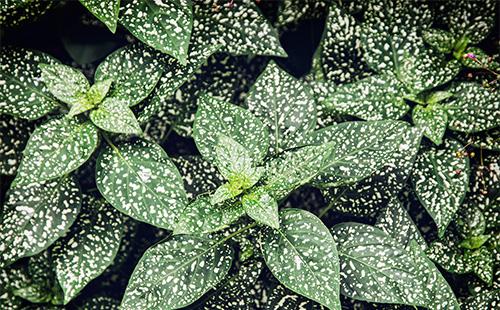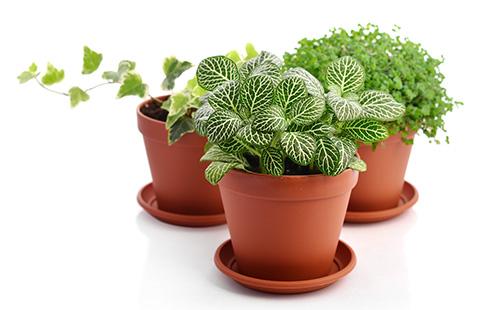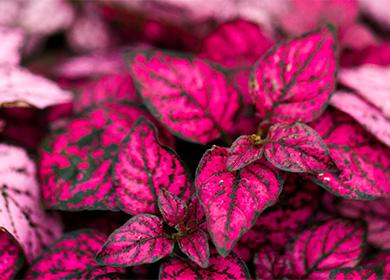The content of the article
Tropical plant belonging to the acanthus family. It is considered unpretentious, but loses its decorative effect when improperly maintained. Looks good in flower arrangements.
Appearance and Origin
In nature, grows in the form of a small shrub. The natural habitat is the tropical rainforests of the island of Madagascar. Less common in tropical regions of Africa. Most species are very small - about 30 cm. Some species grow up to 60 cm, sometimes even higher. Branches are juicy, semi-lignified, highly branched. Growth is fast - hypoesthes can reach its maximum size in just a season.
In room culture, decorative leaves of interesting coloration are valuable. Chaotic spots of different sizes of contrasting colors are scattered on a dark green background. In different varieties, spots are painted in burgundy, white, pink shades. Requires regular shaping to maintain splendor.
The leaves on the stem are opposite. The shape is ovoid, the tip is slightly pointed. Leaves are attached to stems with petioles. The edges are slightly jagged or completely smooth. It blooms with small tubular flowers collected in semi-umbrellas or heads. The flowers are purple, modest, but harmoniously combined with dark or variegated foliage of hypoesthesia.
Varieties and varieties
Only a few dozen natural species of hypoesthesis are known. Most of them are unsuitable for growing in an apartment. In pot culture, two types of hypoesthesia are mainly used. Based on these species, many interesting hybrid varieties are bred.
- Blood red. The most common type of hypoesthes in the culture. It grows mainly in Madagascar. Prefers the shaded corners of the tropics. Grows in the form of a low, highly branched shrub of half a meter height. Leaves of narrowed ovoid shape with smooth, slightly wavy edges. The color is dark green with contrasting purple streaks and randomly scattered red spots. Inflorescences are small, flowers are faded purple.
- Leaf-spike hypoesthes. Leaflets are soft, delicate, purple-red colors. Inflorescences are single, lavender hue, located in the axils of the leaves. Based on the species, breeders have bred many varieties.
Features of hypoesthesia care
How to care for hypoesthesia? The requirements for the conditions of detention are minimal. Hypoesthes is suitable for busy people and beginner flower growers. It’s enough to remember the basics of care.
- Lighting. Full coverage is needed in any season. An open sun is undesirable - hypoesthes are shaded with a thin tulle. Refers to long daylight crops. In winter, natural light is not enough - it is advisable to install fluorescent lamps. With a lack of light, plants do not die, but their decorativeness suffers - beautiful spots are smoothed out.
- Temperature. He loves warmth at any time of the year. In summer, the temperature is maintained in the range of 22-25 ° C, in winter - not lower than 17 ° C. Hypoesthes is very sensitive to drafts and temperature extremes.
- Watering. In the warm season, hypoesthesia is strongly recommended to be watered immediately after the soil surface has dried. Full drying of the soil is avoided - hypoesthesia responds to drought by dropping foliage. In the fall, the intensity of irrigation is gradually reduced; in winter, it is minimized. After drying, the surface of the substrate is watered only after two days.
- Humidity. One of the main conditions for good growth is high humidity. Regular spraying with warm, settled water is an obligatory procedure to maintain decorative leaves. Take measures to further increase the level of humidity. Common methods - hanging batteries with a wet cloth in the heating season, the use of special humidifiers. The pot can be installed on a pallet filled with decorative pebbles or other filler, periodically pour a small amount of water there.
- The soil. Recommended acidity is 5-6 pH. The soil is made on the basis of sheet land with the addition of humus, peat and sand. The addition of coal chips, soaked hydrogel granules is welcome.
- Top dressing. Fertilizers with a high concentration of potassium are chosen. Potassium helps preserve the peculiar color of the leaves. Fertilizing spend the entire warm season at monthly intervals. During the flowering period, you can feed additionally.
- Transfer. Transplanted annually with a complete replacement of the soil. Hypoesthes care after transplantation - moderate watering, mandatory shading from the sun, regular spraying. You can spray with a solution of the drug "Zircon" or "Epin."
- Pruning. Strongly cut off the hypoesthesia is not necessary - it is enough to regularly pinch the growth points of the shoots. This stimulates lateral branching, contributes to the formation of a lush, dense bush.
Breeding methods
Hypoesthes is propagated by seeds and cuttings. Seeds are easy to get from your plant, but you need to catch the moment of their ripening. Ripened seeds can be sifted out and sprout independently in all neighboring pots.

Growing seedlings from seeds
The easiest way to get many plants at the same time is to grow hypoesthesia from seeds at home. Seeds germinate amicably, seedlings grow rapidly. To grow healthy seedlings, it is recommended that you follow the following sequence of five steps.
- A light substrate of peat and sand is prepared. Fill the mixture with a wide, low container.
- The surface of the substrate is sprayed from the spray gun, seeds are sown, lightly sprinkled with sand on top. The seeds are small - they do not need to be deeply buried.
- The container is covered with glass, put in a bright place. Monitor the temperature - it should not fall below 22 ° C.
- Seeds will sprout in less than a week. The glass is immediately removed. Daily check the humidity of the substrate, if necessary, spray from the spray gun.
- The grown seedlings can be planted in separate pots.
For the first time, pinch the growth point when the hypoesthes grows to 10 cm. Next, regularly pinch the side shoots. Within four months you will receive a lush bush.
Cuttings
An equally effective method is the propagation of hypoesthes by cuttings in water.Root cuttings are rooted precisely in the water - in the soil they are long and reluctant to let the roots out. There will be no difficulty with rooting if you stick to the five-step scheme below.
- In spring, cut the required number of cuttings up to 10 cm long. The cut is made oblique.
- Cuttings are placed in a container, filled with water and left for a day.
- The next day, the cuttings are set horizontally in an opaque jar. Create a greenhouse effect - put on top of a plastic bag. They make sure that the leaves do not touch its edges.
- The greenhouse is kept in a warm, bright place. They do not set in the open sun.
- After the appearance of the roots, the cuttings are planted in small pots. Several cuttings are planted in each pot at once to obtain a lush bush.
Common problems
Judging by the reviews, problems with hypoesthesia do not occur too often. But with gross violations of care or conditions of detention, you may encounter yellowing, falling leaves. The most common causes are pests, dry air, irregular watering. Typical problems with hypoesthesia cultivation are given in more detail in the table.
Table - Problems growing hypoesthesia
| A problem | Possible reasons |
|---|---|
| Hypoesthesia leaves wrapped | - Pests (aphids or mites); - watering with fertilizer of high concentration |
| Leaf edges dry | - Too dry air |
| Leaves fall | - dry soil; - sharp fluctuations in temperature; - cold |
| Leaves turn yellow, lose elasticity | - Excessive or irregular irrigation |
| Hypoesthes loses its characteristic color, stretches | - lack of light |
| The leaves are covered with brown spots. | - Sunburn |
| Leaves fade, unexpressed yellowness appears | - Excess nitrogen in the fertilizer |
In each of these cases, the problem is solved by eliminating the care error. With plants that have lost their decorativeness, cuttings are cut to replace them.

Frequent pests
Delicate juicy leaves of hypoesthesia attract pests. Especially often you have to deal with aphids, scale insects, spider mites. For pest control and treatment of plants adhere to approximately the same scheme - mechanically cleaned from pests and treated with insecticides. More details can be found in the table.
Table - Hypoesthesia Pests
| Insect | External manifestations | Ways to fight |
|---|---|---|
| Aphid | - Twisting the tops or individual leaves; - sticky discharge; - secondary attachment of soot fungus | - The twisted tops of the hypoesthesia are cut off; - the plant is thoroughly washed with soapy water; - sprayed with tobacco dust infusion |
| Spider mite | - On the leaves appear small yellow dots; - the leaves become lethargic, dry, fall off; - individual leaves or the entire flower are completely braided by a thin white web | - Cut the affected leaves and shoots; - they spray hypoesthesia with water and put a plastic bag on it for a day; - sprayed with Derris |
| Shield | - Insects are visible to the naked eye in the form of brown plaques; - hypoesthesia wanes, becomes lethargic | - Insects are removed mechanically; - wipe the hypoesthes with an alcoholized cotton swab; - sprayed with a solution of any insecticide |
Knowing how to properly care for hypoesthesia, you can achieve maximum decorativeness from a flower.This compact plant looks good on its own and as part of compositions in the interior of small rooms.

